- Causes of Small Tomatoes and How to Solve Them
- 1. Lack of Water
- 2. Insufficient Nutrients
- 3. Poor Pollination
- 4. Overcrowding
- 5. Pests and Diseases
- 6. Temperature Extremes
- Insufficient Pollination
- Inadequate Nutrient Levels
- Improper Watering Techniques
- Temperature Extremes
- 1. Ideal Temperature Range
- 2. Protecting from Heat
- 3. Protecting from Cold
- 4. Air Circulation
- 5. Monitoring and Adjusting
- Pest and Disease Infestation
- Pests:
- Diseases:
- Pruning and Trimming Methods
- 1. Remove Suckers
- 2. Trim Excess Foliage
- 3. Prune Yellow or Diseased Leaves
- 4. Use Stakes or Trellises
- 5. Maintain Proper Plant Density
- 6. Regularly Inspect and Adjust
- Choosing the Right Tomato Varieties
- Growth Habit
- Flavor and Use
- Growing Conditions
- Personal Preferences
- Harvesting Tips for Maximum Yield
- 1. Choose the right time to harvest
- 2. Be gentle when picking
- 3. Harvest regularly
- 4. Store them properly
- 5. Use pruning techniques
- 6. Provide proper support
- 7. Water and fertilize consistently
- “Question-Answer”
- Why are my tomatoes still small even though they are turning red?
- How can I maximize my tomato harvest?
- What can I do if my tomato plants aren’t producing large fruits?
- Can tomatoes ripen off the vine?
- What is the ideal time to harvest tomatoes?
- “Video” How to Trick Tomatoes into Producing Earlier and Ripening Faster
Tomatoes are one of the most popular plants for home gardeners, and there’s nothing quite like the taste of a freshly picked, ripe tomato. However, if your tomatoes are turning red but still too small, it can be frustrating and disappointing. Don’t worry, though – there are several reasons why this might be happening, and there are steps you can take to maximize your tomato harvest.
Firstly, one reason your tomatoes may be turning red but still small is because of stress. Tomatoes are sensitive plants, and they can experience stress from drought, extreme temperatures, or lack of nutrients. When a tomato plant is stressed, it directs its energy towards ripening the existing fruits rather than producing new ones, resulting in smaller fruits. To address this issue, make sure your tomato plants are getting sufficient water, protect them from extreme weather conditions, and provide them with adequate nutrients through fertilizer.
Another possible reason for small, red tomatoes is insufficient pollination. Tomatoes are usually self-pollinating, but sometimes they may not be able to produce enough pollen on their own. In such cases, the flowers may not be properly fertilized, leading to smaller fruits. To improve pollination, you can gently shake the tomato plants to release more pollen or use a small brush to transfer pollen from one flower to another. Additionally, attracting pollinators like bees to your garden can also help increase fruit size.
In conclusion, if your tomatoes are turning red but staying small, it’s important to address the underlying issues causing this problem. By ensuring that your plants are not under stress, providing them with sufficient water, protecting them from extreme weather, and improving pollination, you can maximize your tomato harvest and enjoy a bountiful crop of delicious, full-sized tomatoes.
Causes of Small Tomatoes and How to Solve Them
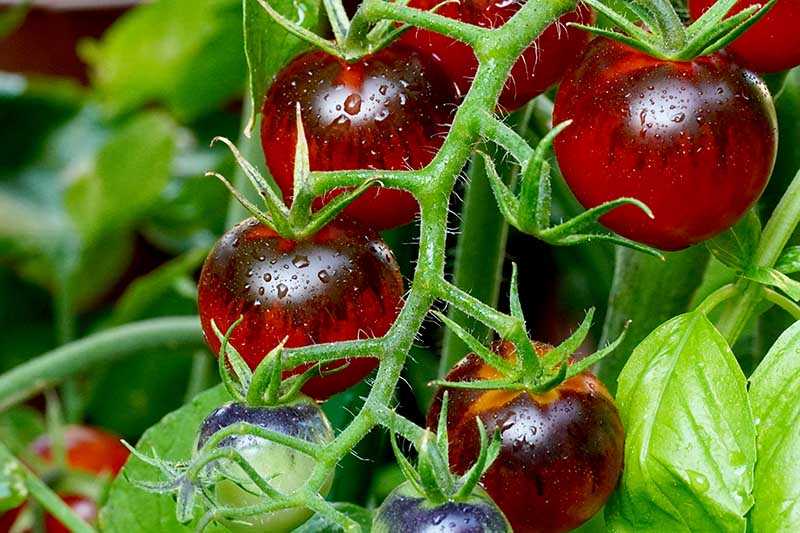
Small tomatoes can be a common issue for many gardeners. Understanding the causes of small tomatoes can help you take the necessary steps to solve the problem and maximize your harvest. Here are some common causes of small tomatoes and tips on how to address them:
1. Lack of Water
Tomatoes require consistent moisture to grow and develop properly. Lack of water can cause stress to the plants and result in smaller fruit. Make sure to provide adequate water to your tomato plants, especially during dry periods. Regular watering, avoiding both underwatering and overwatering, is key to ensuring healthy tomato plants and larger fruit.
2. Insufficient Nutrients
Tomatoes are heavy feeders and require a rich soil with balanced nutrients to thrive. If your plants are not getting enough nutrients, the development of tomatoes can be stunted, leading to smaller fruit size. To solve this issue, enrich the soil with organic matter, such as compost or aged manure, before planting. Additionally, providing a balanced fertilizer during the growing season can help provide the necessary nutrients for optimal tomato growth.
3. Poor Pollination
Inadequate pollination can lead to small, misshapen tomatoes. Tomatoes are typically self-pollinating, but they can benefit from pollinators, such as bees, to ensure proper fruit development. To attract pollinators to your garden, plant flowers that provide nectar and pollen, such as marigolds or bee balm. You can also gently shake or tap the tomato plants to help release pollen and improve pollination.
4. Overcrowding
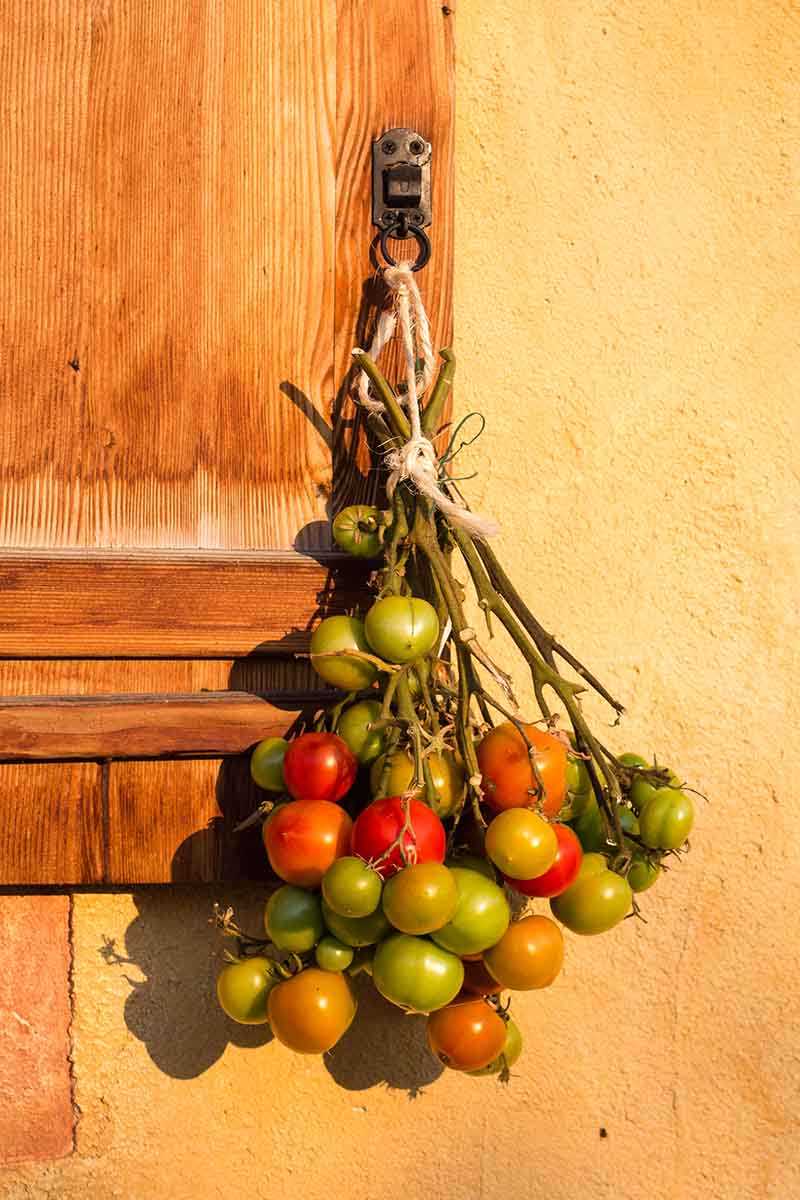
Planting tomatoes too close together can lead to competition for resources, including water, nutrients, and sunlight. This can result in smaller tomatoes. To solve this issue, provide adequate spacing between tomato plants, following the recommended spacing guidelines for the specific variety you are growing. Proper spacing allows each plant to access the necessary resources for optimal growth and fruit development.
5. Pests and Diseases
Pests and diseases can affect the overall health and development of tomato plants, resulting in smaller fruit. Common pests that can cause damage to tomatoes include aphids, caterpillars, and tomato hornworms. To prevent pest infestations, regularly inspect your plants for signs of pests and take appropriate measures, such as using organic pest control methods or removing affected parts of the plant. Additionally, diseases such as tomato blight or wilt can impact fruit size. Choose disease-resistant varieties, practice crop rotation, and maintain good garden hygiene to minimize the risk of diseases.
6. Temperature Extremes
Tomatoes prefer warm conditions for optimal growth and fruit development. Extreme temperatures, both very high or very low, can negatively affect tomato plants and result in smaller fruit. Protect your plants from extreme temperatures by providing shade during hot summer days and using row covers or other protective measures during cold snaps. Ensuring a stable and suitable temperature range can help promote larger tomato fruit.
By addressing these common causes of small tomatoes, you can maximize the size and quality of your harvest. Providing adequate water, nutrients, and pollination, as well as preventing overcrowding, pests, diseases, and temperature extremes will help your tomato plants thrive and yield delicious, juicy tomatoes.
Insufficient Pollination
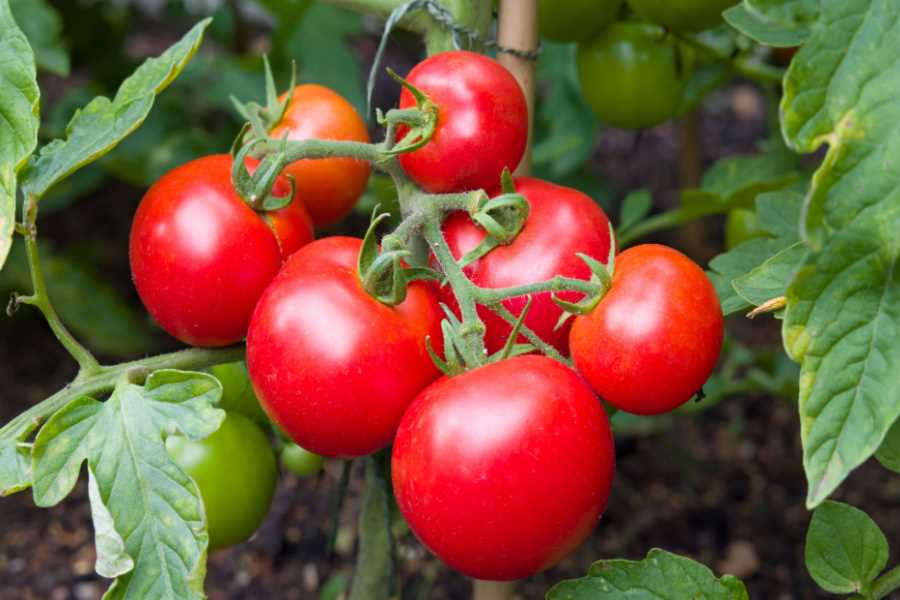
If your tomatoes are turning red but still too small, the issue may be insufficient pollination. Tomatoes are self-pollinating plants, but they still rely on wind, bees, and other pollinators to transfer pollen between flowers.
When tomatoes are not properly pollinated, the fruits may fail to develop fully or remain small in size. There are a few reasons why pollination may be inadequate:
- Lack of pollinators: If there are not enough bees or other pollinators in your garden, the tomato flowers may not be receiving enough pollen. You can attract pollinators by planting flowers that they are attracted to, such as marigolds or zinnias, or by providing a water source.
- Weather conditions: Cold or rainy weather can reduce the activity of pollinators, making it more difficult for them to visit the tomato flowers. Consider covering your plants with row covers or providing shelter to protect them during unfavorable weather conditions. You can also try gently shaking the tomato plants to stimulate the release of pollen.
- Improper spacing: If your tomato plants are overcrowded, pollinators may have difficulty accessing the flowers. Make sure to space out your plants properly to ensure good air circulation and make it easier for pollinators to reach all the flowers.
- Low humidity: Dry conditions can hinder the transfer of pollen. To increase humidity around your tomato plants, you can mist them with water or use a humidifier.
If you suspect insufficient pollination is the cause of your tomatoes being small, you can try hand-pollinating them. Gently shake the tomato plant to release the pollen, then use a small paintbrush to transfer the pollen from the stamens to the pistil of each flower.
By addressing the issue of insufficient pollination, you can help ensure that your tomatoes reach their full size and maximize your harvest.
Inadequate Nutrient Levels
A common reason why tomatoes may be turning red but still too small is inadequate nutrient levels in the soil. Tomatoes are heavy feeders that require a balance of essential nutrients to grow and produce full-size fruits.
Here are some key nutrients that are crucial for tomato growth:
- Nitrogen: Nitrogen is essential for leaf and stem growth. Lack of nitrogen can result in stunted plants and small fruits. Consider using a nitrogen-rich fertilizer or adding organic matter such as compost or manure to boost nitrogen levels in the soil.
- Phosphorus: Phosphorus is necessary for root development and fruit production. Insufficient phosphorus can lead to weak plants and poor fruit set. Apply a phosphorus-rich fertilizer or bone meal to provide adequate phosphorus for your tomatoes.
- Potassium: Potassium promotes overall plant health and helps in fruit development and ripening. Potassium deficiency can cause smaller fruits that fail to fully ripen. Add potassium-rich fertilizers or wood ash to enhance potassium levels in the soil.
In addition to these major nutrients, tomatoes also require other micronutrients like calcium, magnesium, and iron. Deficiencies in these micronutrients can stunt plant growth and affect fruit size.
It is important to regularly test the soil to assess nutrient levels and make necessary adjustments. Soil amendments such as fertilizers and organic matter can be added to ensure a well-balanced nutrient supply for your tomatoes.
Remember, providing adequate nutrition to your tomato plants is crucial for their growth and productivity. By addressing inadequate nutrient levels in the soil, you can maximize your harvest and enjoy plump, delicious tomatoes.
Improper Watering Techniques
Proper watering is essential for healthy tomato plants and a bountiful harvest. If your tomatoes are turning red but still too small, it could be due to improper watering techniques. Here are some common mistakes to avoid:
- Overwatering: Overwatering can drown the roots of tomato plants and prevent them from taking up essential nutrients. It can also lead to disease and root rot. Make sure to water your plants deeply but infrequently to allow the soil to dry out between waterings.
- Underwatering: On the other hand, underwatering can cause stress to the plants and stunt their growth. Tomatoes need consistent moisture, especially during periods of hot weather. Check the soil regularly and water when the top inch is dry.
- Inconsistent watering: Inconsistent watering can cause fluctuations in soil moisture levels, which can stress the plants and lead to small, underdeveloped fruits. Water your tomato plants consistently and avoid allowing the soil to completely dry out.
- Watering from above: Watering the foliage of tomato plants instead of directly at the root zone can result in wasted water and increase the risk of disease. Always water at the base of the plants to ensure the water reaches the roots.
To ensure proper watering, consider using a soaker hose or drip irrigation system to deliver water directly to the root zone. This will help to conserve water and reduce the risk of overwatering or underwatering. Additionally, applying a layer of organic mulch around the base of the plants can help to retain moisture in the soil.
Remember, consistent and appropriate watering is vital for the healthy growth of tomato plants and the development of large, juicy fruits. By avoiding these common watering mistakes, you can maximize your tomato harvest and enjoy a delicious crop of ripe, red tomatoes.
Temperature Extremes
Tomatoes are sensitive to temperature extremes, and this can affect their growth and development. When exposed to very high temperatures, the plants may experience heat stress, which can cause the flowers to drop and prevent the fruits from setting.
On the other hand, when the temperatures are too low, the tomatoes may not ripen properly and remain small in size. Cold temperatures can also slow down the growth of the plant, leading to smaller fruits.
To maximize your tomato harvest, it’s important to provide the plants with the right temperature conditions:
1. Ideal Temperature Range
Tomatoes thrive in temperatures between 70°F and 85°F (21°C and 29°C). This temperature range allows for optimal growth and fruit set. Outside of this range, the plants may struggle to produce ripe and full-sized tomatoes.
2. Protecting from Heat
During hot summer months, it’s crucial to protect tomato plants from excessive heat. You can provide shade by using shade cloth or planting tall crops nearby to create a natural shade. Mulching around the plants can also help to keep the soil cool and prevent the plant from heat stress.
3. Protecting from Cold
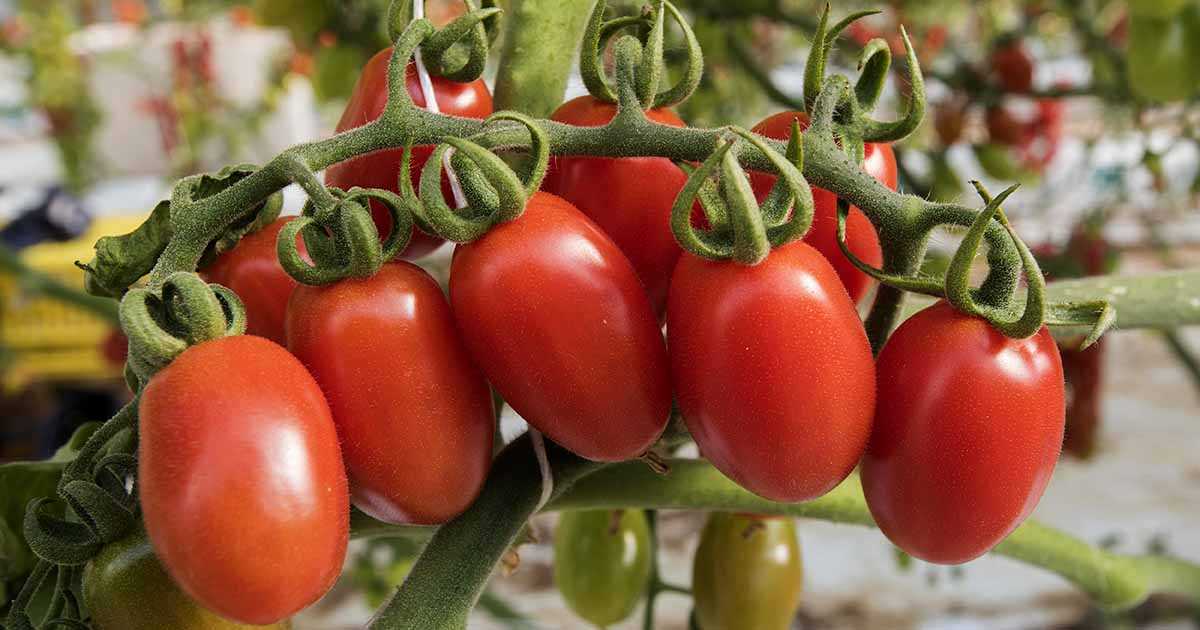
If you experience cold temperatures, especially during the early spring or late fall, you can use various methods to protect your tomatoes. Covering the plants with frost blankets or cloths can help to trap the heat and protect the plants from frost. Using row covers or cold frames can also provide insulation and keep the plants warm.
4. Air Circulation
Adequate air circulation is important for maintaining the temperature around the tomato plants. If the air becomes stagnant, it can lead to heat buildup or cold pockets. To improve air circulation, make sure to space the plants properly, prune any crowded branches, and avoid planting in areas with high wind blockage.
5. Monitoring and Adjusting
It’s essential to monitor the temperature regularly and make adjustments accordingly. Use a thermometer to measure the temperature around the plants and make necessary changes to protect them from extreme temperatures. This may include adjusting shade cloths, adding or removing mulch, or using additional heat sources in cold weather.
By providing the right temperature conditions and taking necessary precautions, you can help your tomato plants thrive and ensure a bountiful harvest of ripe and full-sized tomatoes.
Pest and Disease Infestation
Pest and disease infestation can be a major factor in preventing tomatoes from reaching their full growth potential. Here are some common pests and diseases that can affect tomato plants:
Pests:
- Aphids: These tiny insects can suck the sap out of tomato plants, causing stunted growth and distorted leaves.
- Whiteflies: Whiteflies are small insects that feed on the undersides of tomato leaves, causing yellowing and stunted growth.
- Hornworms: These large caterpillars can devour tomato leaves and fruit, leading to reduced harvests.
- Spider mites: Spider mites are tiny pests that can cause yellowed leaves and webbing on tomato plants, which can inhibit growth.
Diseases:
- Early blight: Early blight is a fungal disease that causes dark lesions on leaves and stems, leading to reduced plant vigor and fruit production.
- Late blight: Late blight is another fungal disease that can cause wilting, dark lesions, and rotting tomatoes.
- Blossom end rot: Blossom end rot is a physiological disorder that results in black, sunken areas on the bottom of tomatoes. It is often caused by calcium deficiency or irregular watering.
- Fusarium wilt: Fusarium wilt is a soilborne fungal disease that causes wilting, yellowing, and eventual death of tomato plants.
To prevent and manage pest and disease infestations, it is important to implement good gardening practices:
- Ensure proper spacing between tomato plants to allow for adequate air circulation and reduce the risk of disease spread.
- Regularly inspect plants for any signs of pests or diseases and take immediate action if necessary.
- Remove any infected or infested plant material to prevent the spread of diseases.
- Consider using natural pest control methods such as introducing beneficial insects or using organic sprays.
- Maintain proper watering and fertilization to promote healthy plant growth and minimize the risk of physiological disorders like blossom end rot.
By being proactive and implementing preventive measures, you can reduce the impact of pests and diseases on your tomato plants and maximize your harvest.
Pruning and Trimming Methods
Pruning and trimming your tomato plants is an essential step to maximize your harvest. By removing excess foliage and branches, you allow the plant to focus its energy on producing larger, tastier fruits. Here are some pruning and trimming methods you can try:
1. Remove Suckers
Tomato plants often produce side shoots known as suckers, which can sap energy from the main stem. By removing these suckers, you redirect the plant’s resources towards fruit production. Use clean gardening shears or your fingers to pinch off the suckers when they are small.
2. Trim Excess Foliage
Overgrown foliage can shade the developing fruits, preventing them from receiving adequate sunlight. Trim any excessive foliage that blocks sunlight from reaching the fruits. Focus on removing lower leaves that touch the ground as they are more prone to diseases.
3. Prune Yellow or Diseased Leaves
Inspect your tomato plants regularly and remove any yellow or diseased leaves. These leaves can attract pests and diseases, which can hinder fruit development. Pruning them off helps prevent the spread of diseases and keeps the plants healthier.
4. Use Stakes or Trellises
Supporting tomato plants with stakes or trellises not only keeps them upright but also allows better air circulation and sunlight penetration. This promotes even ripening of the fruits and reduces the risk of diseases.
5. Maintain Proper Plant Density
Avoid overcrowding your tomato plants as this can lead to competition for resources and hinder fruit development. Follow the recommended spacing guidelines for your specific tomato variety to ensure adequate airflow and room for each plant to grow.
6. Regularly Inspect and Adjust
Continuously monitor your tomato plants and make adjustments as needed. As the plants grow, they may require further pruning or trimming. Stay vigilant for any signs of pests or diseases and take appropriate action to protect your plants.
By incorporating these pruning and trimming methods into your tomato growing routine, you can ensure healthier plants and a bountiful harvest of red, ripe tomatoes.
Choosing the Right Tomato Varieties
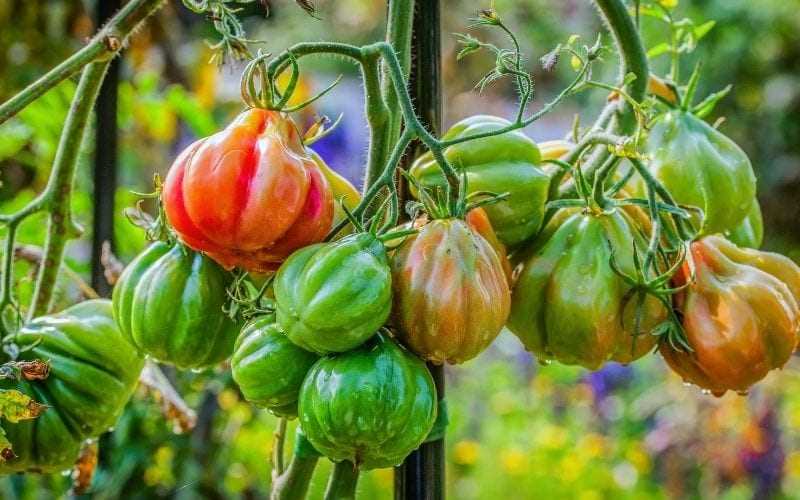
When it comes to growing tomatoes, choosing the right variety is key to maximizing your harvest. There are many different types of tomatoes to choose from, each with their own unique characteristics and flavor profiles. Here are some factors to consider when selecting tomato varieties:
Growth Habit
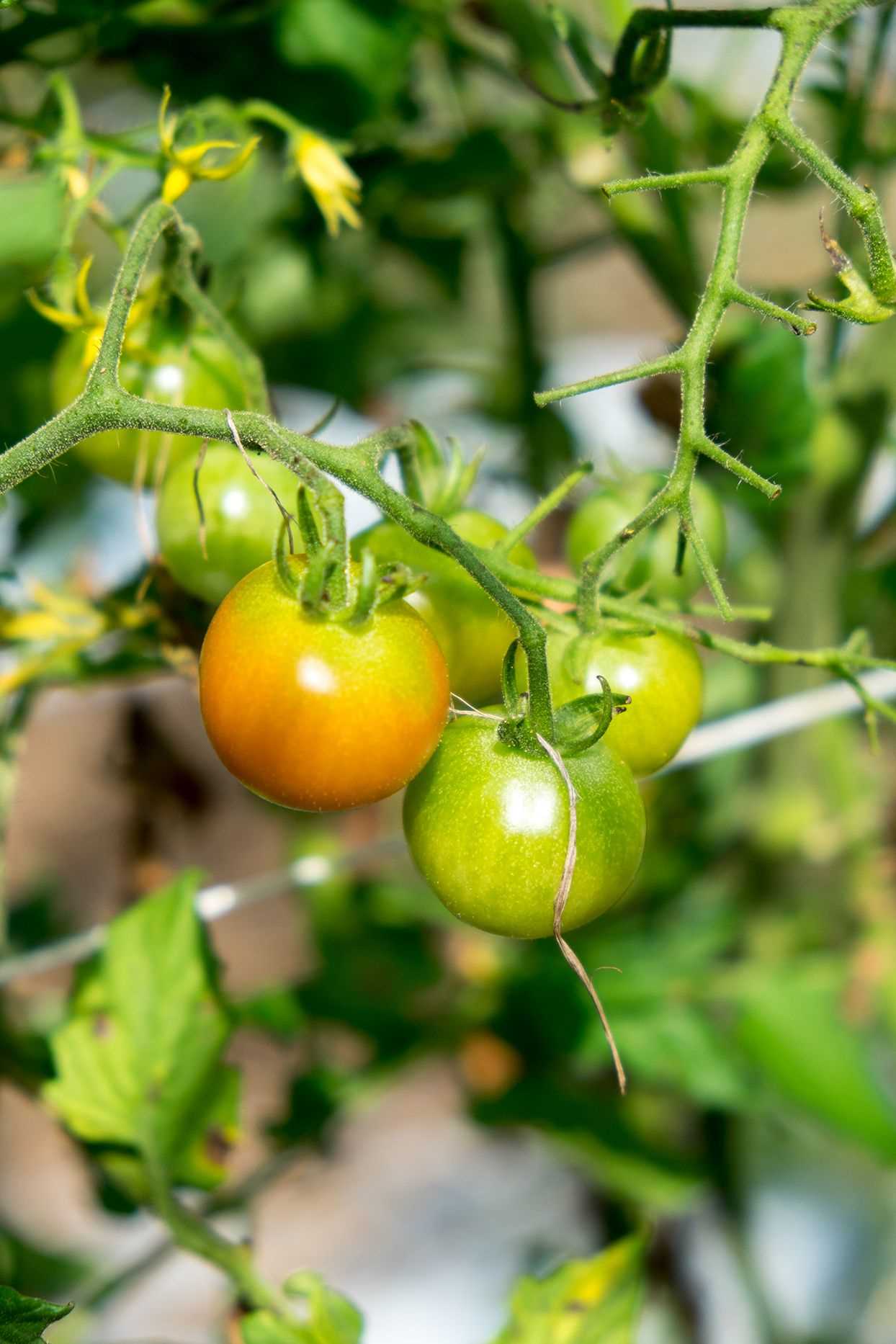
Tomato plants can be categorized into two main growth habits: determinate and indeterminate.
- Determinate: These varieties of tomatoes are more compact and tend to grow to a certain height before stopping. They are great for small spaces and containers, as they don’t require as much support or pruning.
- Indeterminate: These varieties of tomatoes continue to grow and produce fruit throughout the season until frost. They tend to be taller and require more support, such as stakes or cages. Indeterminate tomatoes are ideal for larger gardens or those who want a continuous supply of ripe tomatoes.
Flavor and Use
Consider what you plan to use your tomatoes for when selecting varieties. Some tomatoes are best for fresh eating, while others are better suited for sauces or canning. Here are a few popular tomato types:
- Beefsteak: These tomatoes are large and meaty, perfect for slicing and adding to sandwiches or salads.
- Roma: Roma tomatoes are known for their dense flesh and low seed count, making them ideal for cooking down into sauces or canning.
- Cherry: Cherry tomatoes are small and sweet, perfect for snacking or adding to salads.
Growing Conditions
Be sure to consider your local climate and growing conditions when selecting tomato varieties. Some tomatoes are more resistant to diseases or better suited for hot or cool climates. Check the seed packet or plant label for information on the preferred growing conditions for each variety.
Personal Preferences
Ultimately, the best tomato varieties for you will depend on your personal preferences. Consider the color, size, and shape of the tomatoes you prefer, as well as any specific flavor profiles you are looking for. Don’t be afraid to try different varieties to find your favorites!
By carefully considering these factors, you can choose the right tomato varieties for your garden and enjoy a fruitful harvest of delicious, ripe tomatoes.
Harvesting Tips for Maximum Yield
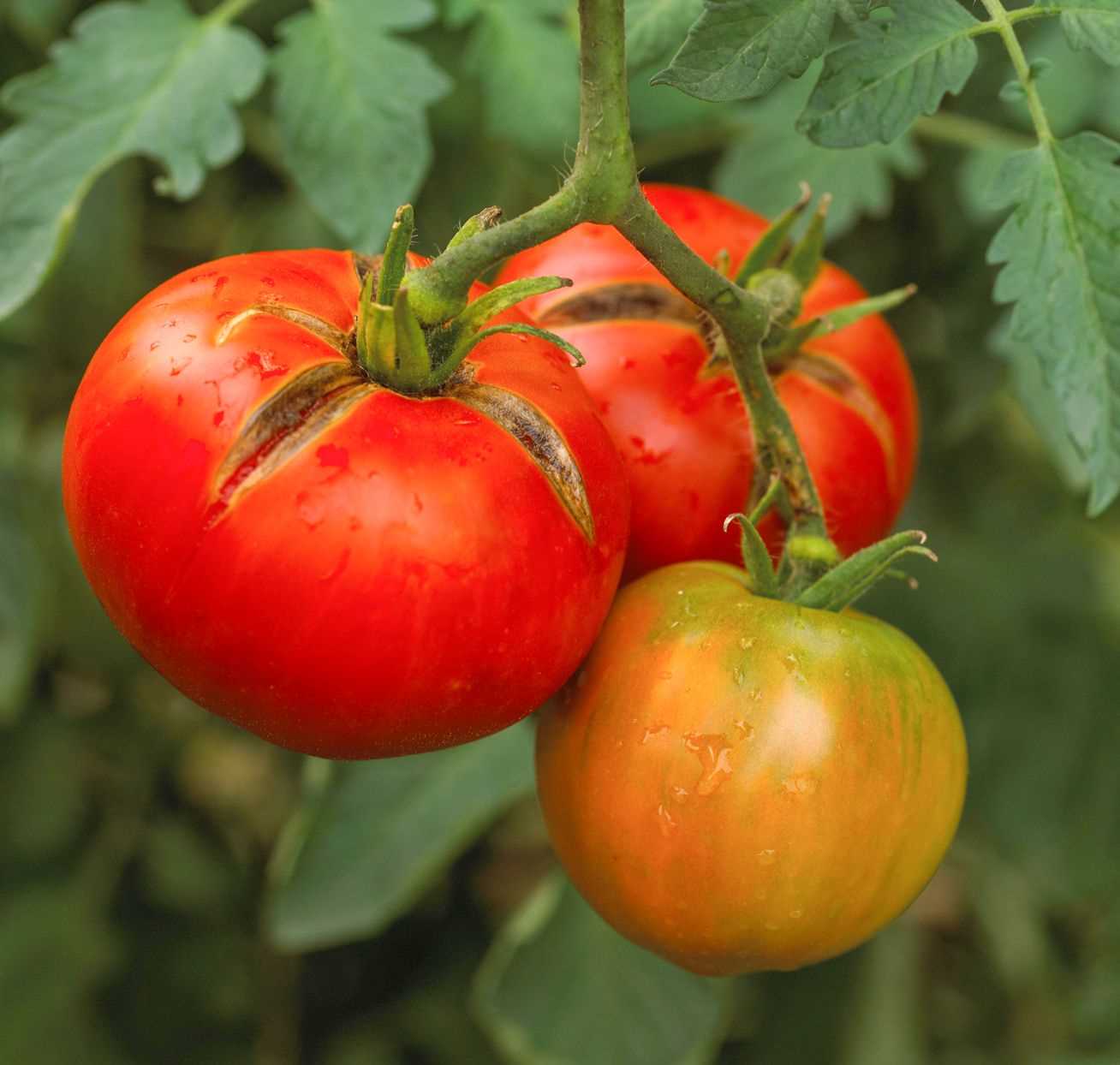
When it comes to growing tomatoes, the goal is not only to have ripe red fruit, but also to maximize the yield of your harvest. Here are some tips to help you achieve that:
1. Choose the right time to harvest
Tomatoes are ready to be harvested when they have reached their full color, depending on the variety. For red tomatoes, they should have a deep red color and be slightly firm to the touch. Avoid picking them when they are still green, as they will not ripen properly off the vine.
2. Be gentle when picking
When harvesting tomatoes, it is important to handle them with care. Use your fingers to gently twist or snap the stem off the vine, rather than pulling the fruit off forcefully. This will help prevent any damage to the plant and ensure that the tomatoes stay in good condition.
3. Harvest regularly
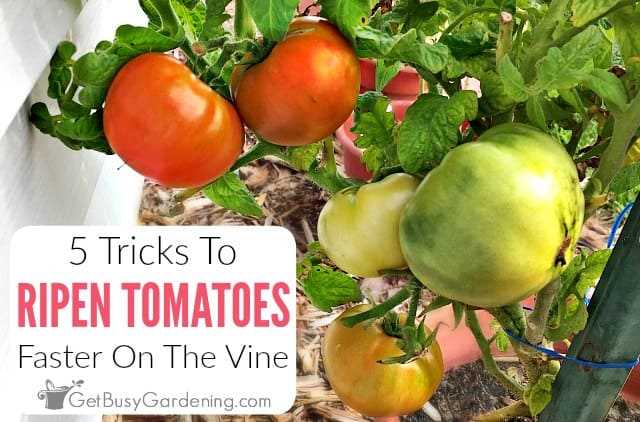
To maximize your tomato yield, it is important to harvest regularly. This means checking your plants every few days and picking any ripe tomatoes. Leaving ripe tomatoes on the vine for too long can lead to overripening, which can attract pests or cause the fruit to split.
4. Store them properly
If you have harvested more tomatoes than you can use immediately, it is important to store them properly to extend their shelf life. Ideally, tomatoes should be stored at room temperature and away from direct sunlight. Avoid refrigerating them, as this can affect their flavor and texture.
5. Use pruning techniques
Pruning your tomato plants can help maximize their yield. By removing some of the excess foliage, you can redirect the plant’s energy towards producing larger and more flavorful fruit. Additionally, pruning can improve air circulation and reduce the risk of diseases.
6. Provide proper support
Tomato plants benefit from proper support, such as stakes or cages, as they grow. This helps keep the plant upright and prevents the fruit from touching the ground, which can lead to rotting or pest damage. Providing support also helps maximize sun exposure and airflow to the plants, resulting in better fruit development.
7. Water and fertilize consistently
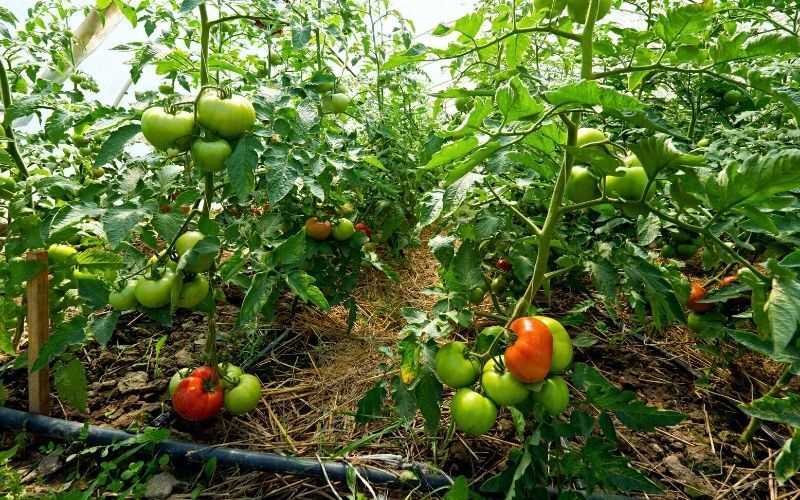
Tomatoes require consistent watering and fertilization to produce a high yield. Ensure that your plants receive regular watering, keeping the soil evenly moist but not waterlogged. Additionally, use a balanced fertilizer formulated for tomatoes to provide them with the necessary nutrients for healthy growth and fruit production.
By following these harvesting tips, you can maximize your tomato yield and enjoy a bountiful harvest of delicious, ripe tomatoes.
“Question-Answer”
Why are my tomatoes still small even though they are turning red?
There are a few reasons why your tomatoes may still be small even though they are turning red. One possibility is that the plants aren’t receiving enough nutrients. Make sure you are providing them with the proper fertilizers and watering them adequately. Another reason could be that the plants aren’t getting enough sunlight. Tomatoes need at least 6-8 hours of direct sunlight per day to grow properly. Lastly, the variety of tomato you are growing could naturally produce smaller fruits.
How can I maximize my tomato harvest?
To maximize your tomato harvest, there are several things you can do. First, make sure you are planting your tomatoes in a location that receives plenty of sunlight. Next, provide them with adequate water and fertilize them regularly to ensure they are getting the nutrients they need. Pruning your tomato plants can also help maximize your harvest by diverting more energy to the remaining fruits. Additionally, removing any diseased or damaged fruits can prevent the spread of disease and increase overall production.
What can I do if my tomato plants aren’t producing large fruits?
If your tomato plants aren’t producing large fruits, there are a few things you can try. First, make sure the plants are receiving enough sunlight, as this is crucial for fruit development. If the plants are already receiving sufficient sunlight, you may need to adjust your watering and fertilizing routine. Overwatering can lead to a dilution of nutrients, while under-watering can hinder fruit development. Additionally, thinning out excess fruits can help redirect energy towards larger ones. Lastly, consider trying a different tomato variety that is known for producing larger fruits.
Can tomatoes ripen off the vine?
Tomatoes can ripen off the vine, although the flavor may not be as good as those ripened on the vine. If you have green tomatoes that you want to ripen, you can place them in a paper bag with a ripe banana or apple. These fruits produce ethylene gas, which helps speed up the ripening process. Keep the bag at room temperature and check the tomatoes daily. Once they reach the desired ripeness, you can store them in the refrigerator to extend their shelf life.
What is the ideal time to harvest tomatoes?
The ideal time to harvest tomatoes depends on the variety, but in general, you want to wait until they are fully ripe on the vine. This is when the tomatoes are firm but give slightly when gently squeezed. The color of the tomato should also be uniform and vibrant. If you are unsure, you can perform a taste test by sampling a tomato from the plant. If it has a good flavor and is at the desired ripeness, it’s time to harvest!







